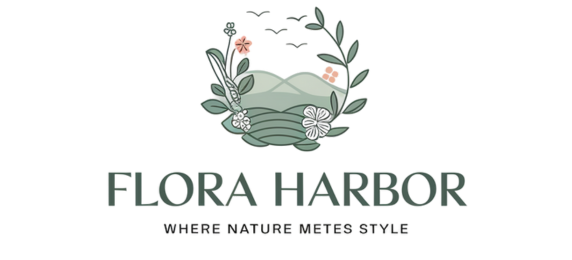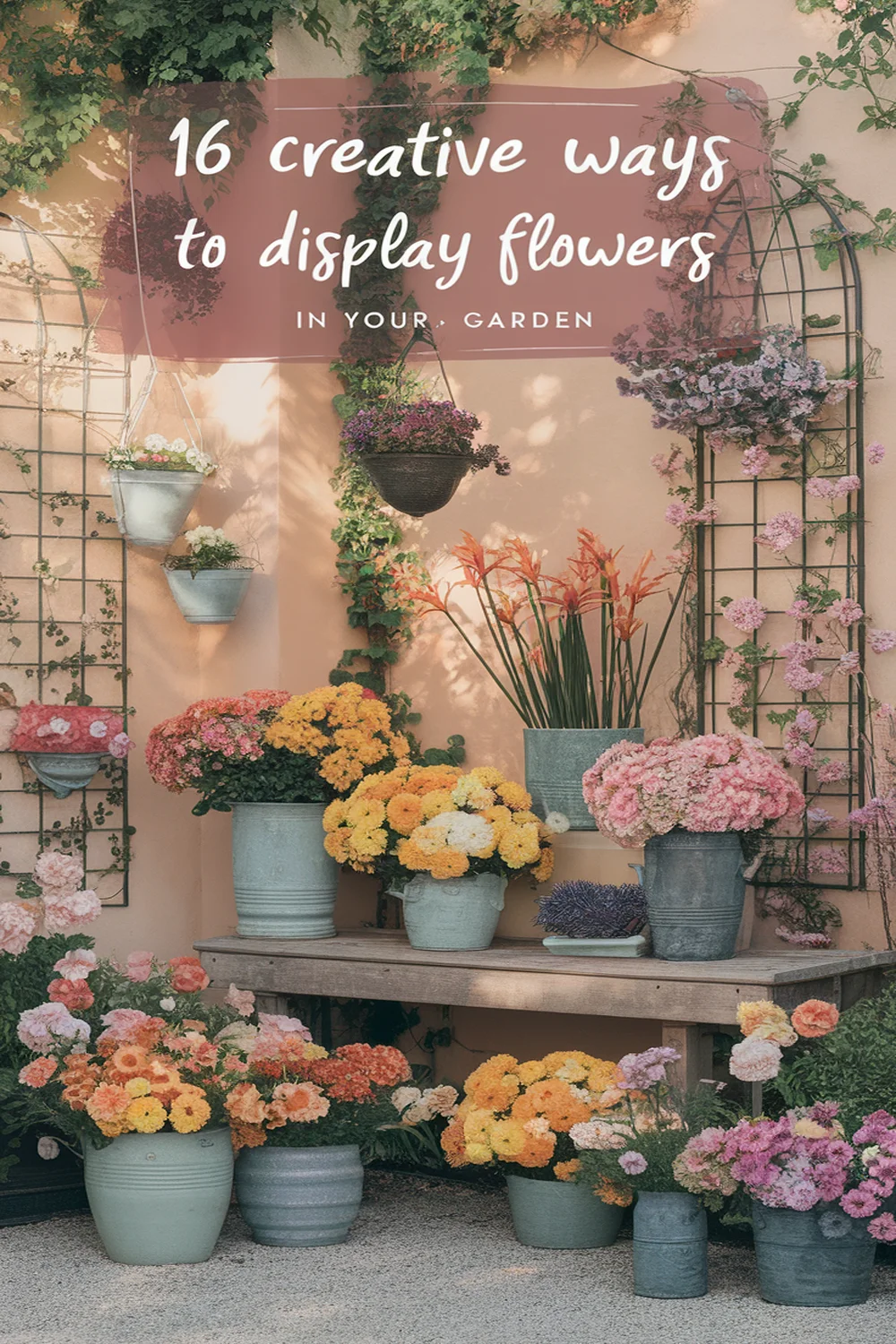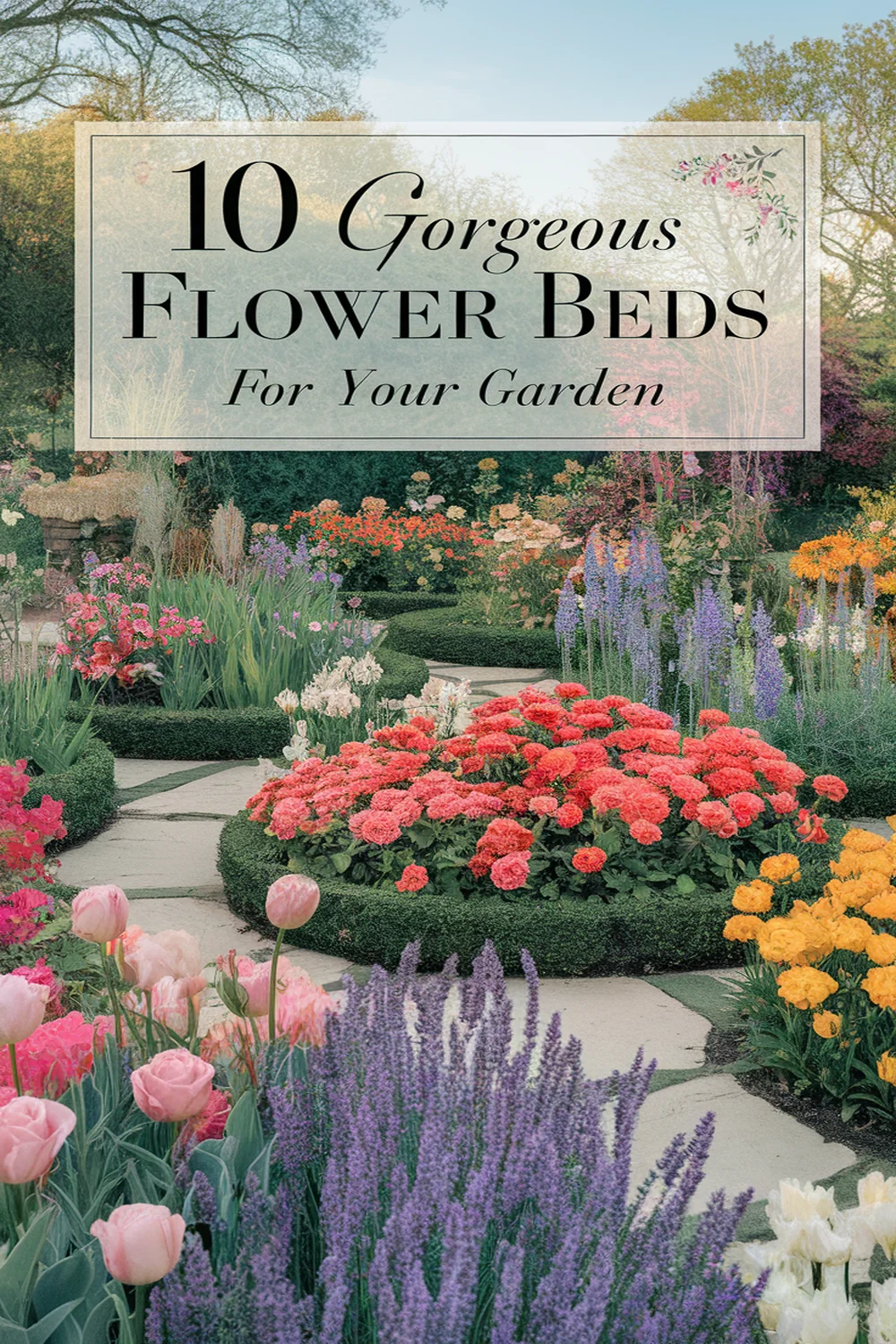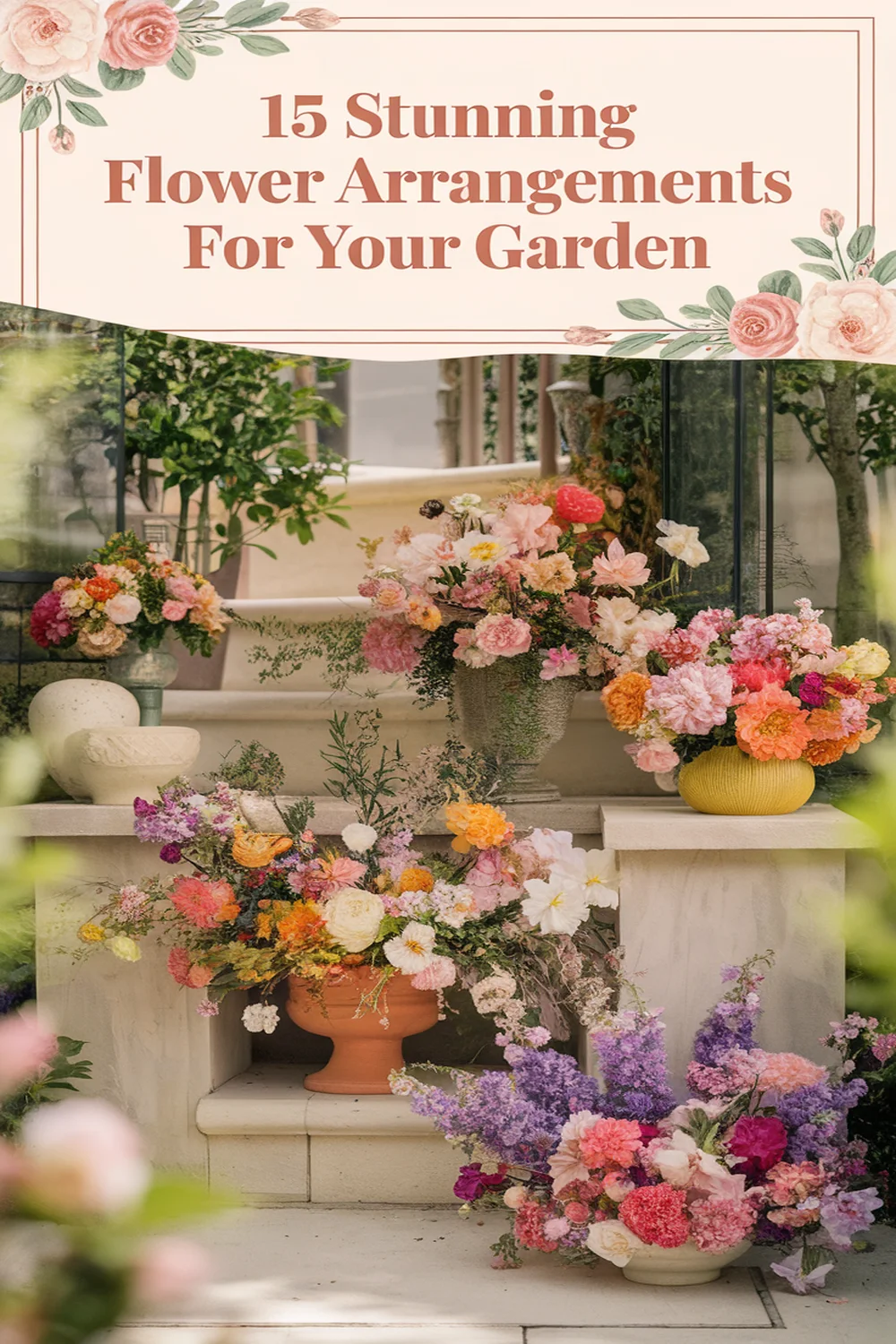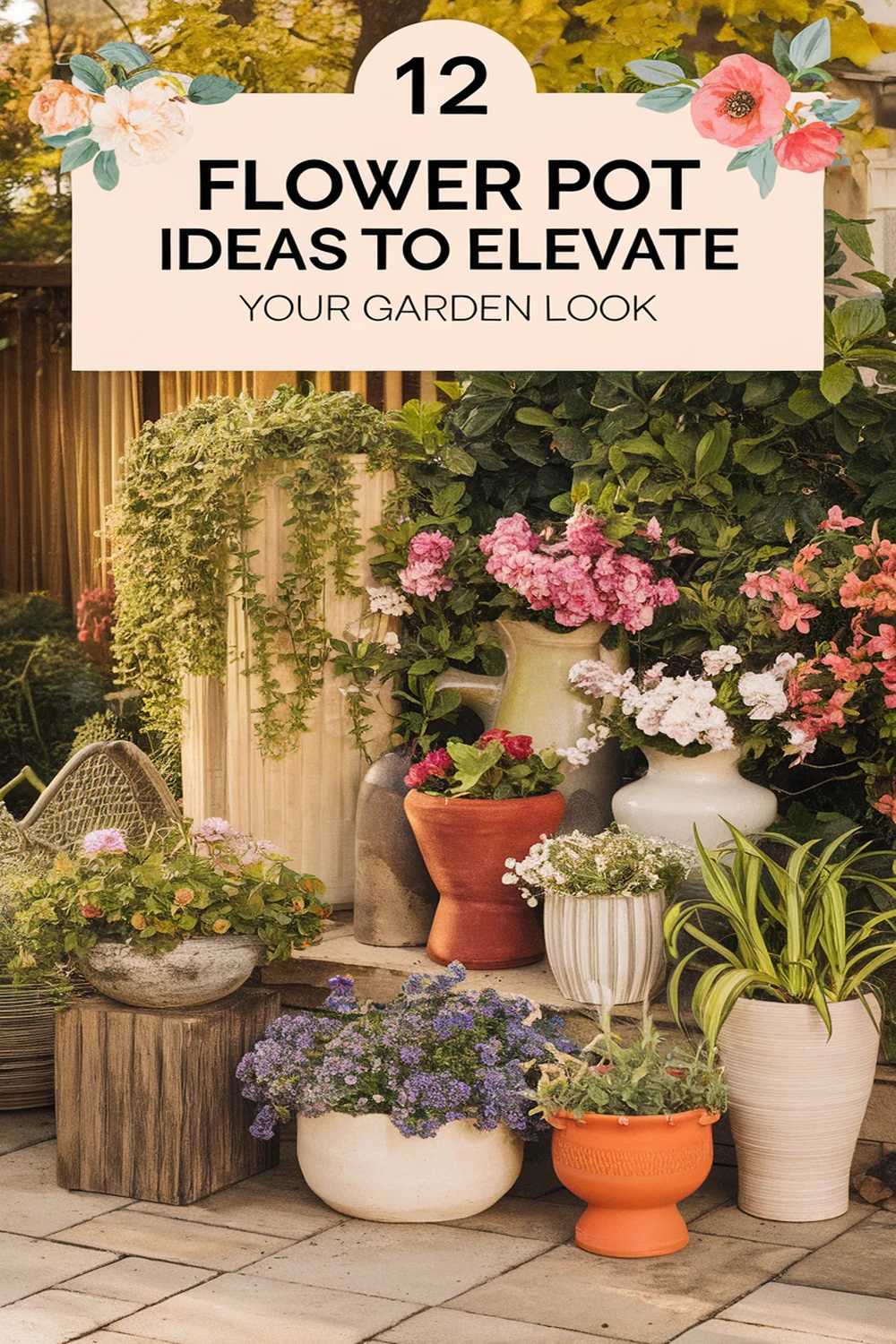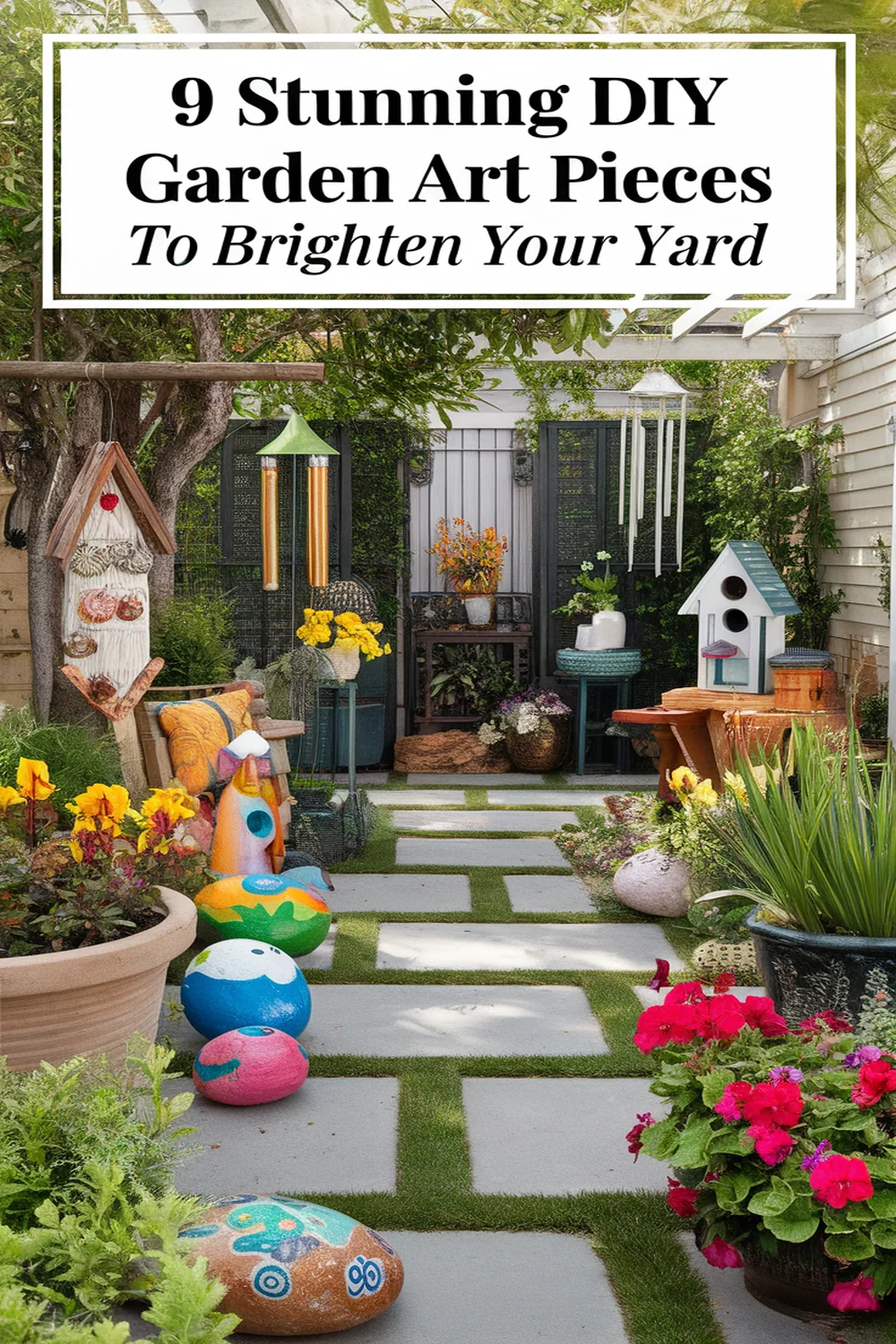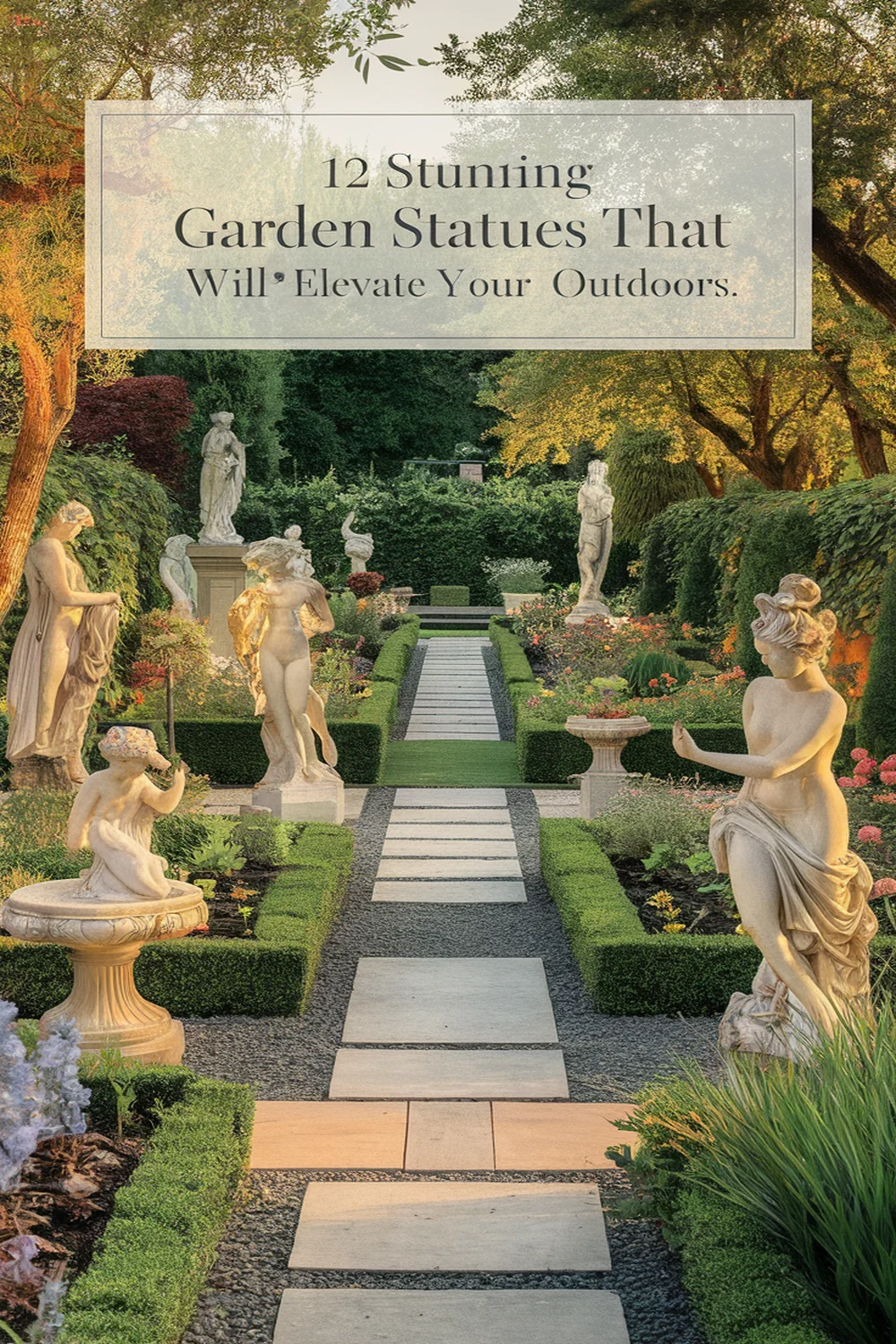This post may contain affiliate links. Please read our policy page.
If you’re looking for beautiful indoor plants that also thrive outdoors, consider options like the resilient Snake Plant and the cascading Pothos. The colorful Croton and vibrant Coleus make stylish statements in any space. Hardy ZZ Plants and the lush Philodendron add elegance while maintaining air quality. Don’t forget the low-maintenance Bromeliad and Hoya for unique aesthetics. These plants can enhance both your indoor and outdoor spaces, and there’s plenty more to explore about each one!
Snake Plant (Sansevieria)
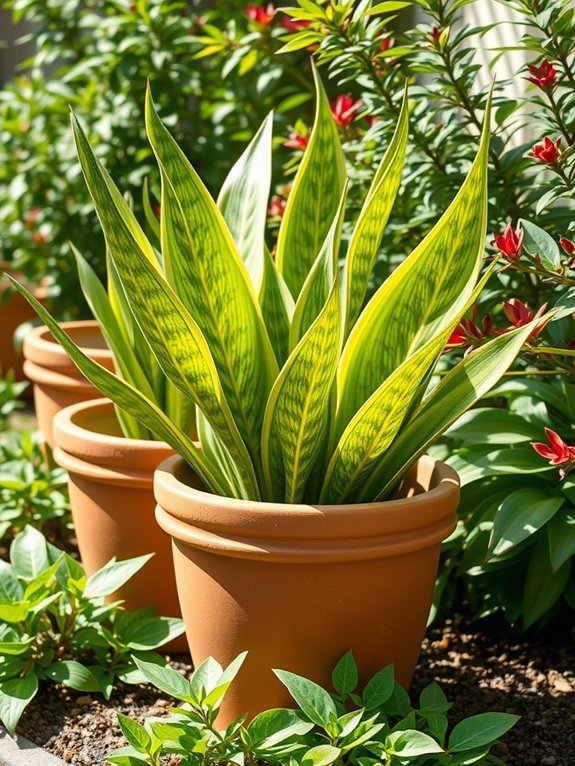
The Snake Plant (Sansevieria) stands out as one of the most resilient indoor plants you can choose. Its sword-like leaves, varying from deep green to variegated yellow and white, add a striking visual element to any space. This plant thrives in low light conditions and requires minimal water—perfect for busy lifestyles. You don’t need to worry about humidity levels, as it adjusts well to drier air. Additionally, the Snake Plant’s air-purifying qualities make it an excellent choice for improving indoor air quality. You’ll appreciate its toughness, as it can withstand neglect, such as missed waterings or lack of attention. By choosing a Snake Plant, you’re opting for a low-maintenance yet attractive addition to your indoor environment that’s sure to flourish.
Pothos (Epipremnum Aureum)
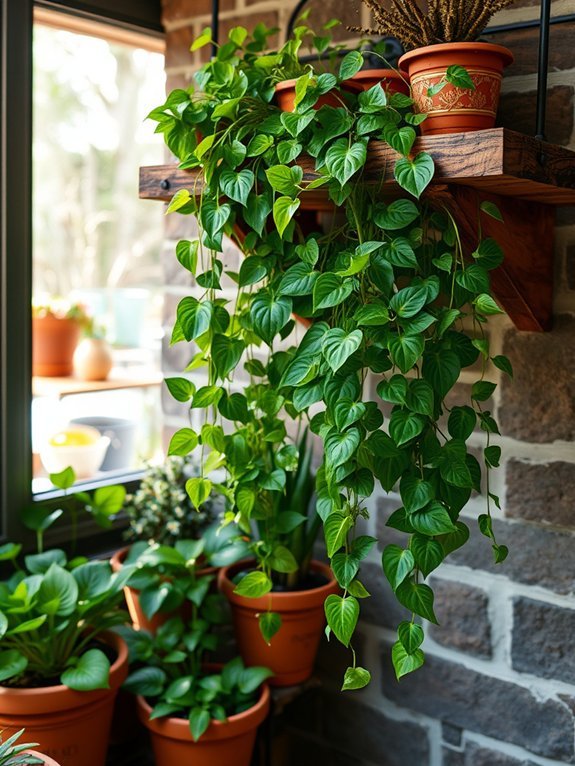
For those looking to introduce a vibrant touch to their indoor spaces, Pothos (Epipremnum Aureum) is an excellent option. This hardy vine thrives in a variety of lighting conditions, from low light to bright indirect sunlight, making it highly adaptable. Its glossy, heart-shaped leaves display fascinating variegation, ranging from deep green to striking yellows and whites. This plant’s growth habit allows it to cascade gracefully from shelves or hang freely in a pot, creating an eye-catching display. Pothos also excels in air purification, effectively removing toxins from your environment. Plus, it’s low-maintenance—just water when the soil feels dry. Whether you’re a beginner or seasoned plant enthusiast, Pothos adds beauty and life to any indoor arrangement.
Spider Plant (Chlorophytum Comosum)
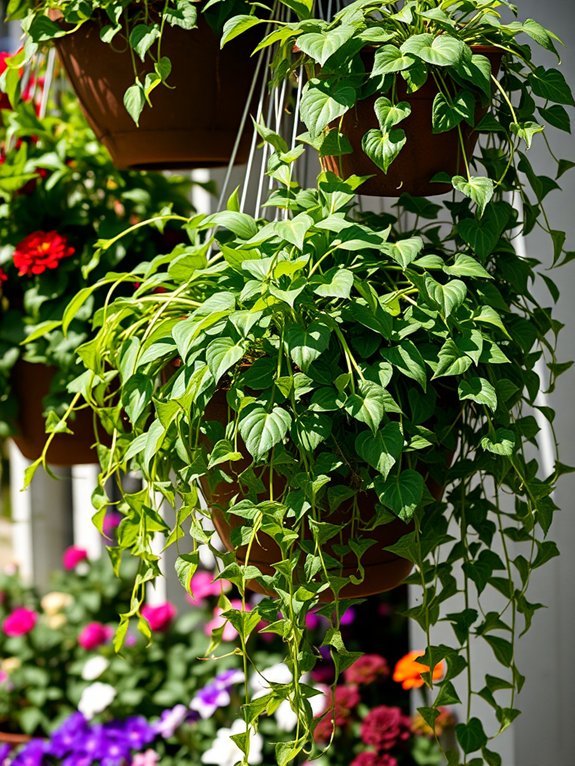
While you might appreciate the aesthetic appeal of various indoor plants, the Spider Plant (Chlorophytum Comosum) stands out with its unique cascading foliage and resilient nature. This plant features long, arching leaves that often come in green and white variegations, adding visual interest to any outdoor space. Spider Plants thrive in bright, indirect sunlight but can tolerate lower light conditions, making them versatile for different locations. They’re also forgiving regarding water; allowing the soil to dry out between waterings is ideal. During warm months, they produce adorable “pups,” which you can propagate or leave for a fuller look. By placing the Spider Plant outdoors, you not only enhance your garden’s charm but also benefit from its air-purifying qualities.
ZZ Plant (Zamioculcas Zamiifolia)

Few indoor plants are as striking and low-maintenance as the ZZ Plant (Zamioculcas Zamiifolia). With its glossy, dark green leaves and unique, upright growth habit, this plant adds a touch of elegance to any space. You’ll appreciate its resilience; it thrives in various light conditions, from low light to indirect sunlight. Its sturdy structure and slow growth mean it requires minimal water, making it an excellent choice if you’re busy or prone to overwatering. When you move it outdoors, guarantee it’s in well-draining soil and provide some shade to prevent leaf scorch. With proper care, the ZZ Plant can adapt beautifully to your garden, enhancing your outdoor aesthetic while remaining hassle-free.
Philodendron
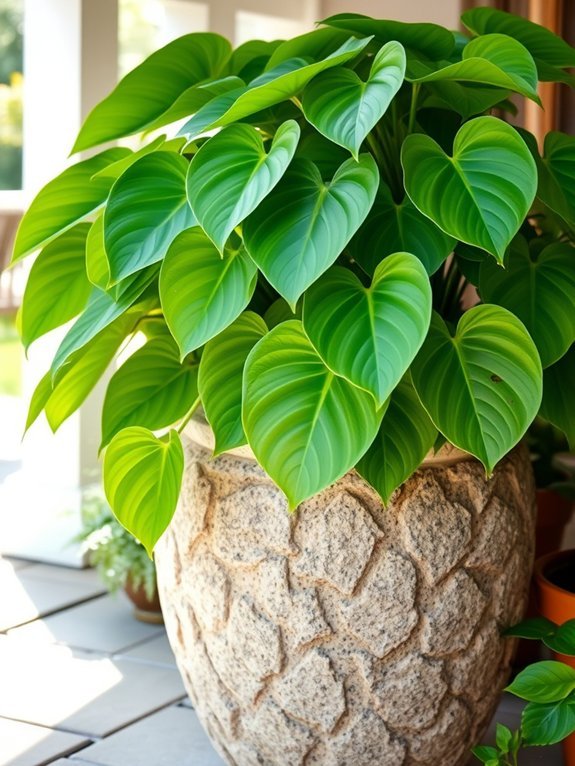
The Philodendron family boasts a diverse range of species, each showcasing lush foliage and unique growth patterns that energize indoor spaces. These tropical plants thrive in bright, indirect light, making them perfect for both homes and outdoor patios. Their heart-shaped leaves come in various sizes, adding texture and visual interest wherever placed. Philodendrons are also known for their air-purifying qualities, helping to enhance indoor air quality. When adapting them outdoors, verify they’re gradually acclimated to prevent shock from direct sunlight. Water them consistently, allowing the top inch of soil to dry out between watering. By nurturing these vibrant plants, you’ll create a revitalizing atmosphere that boosts both aesthetic appeal and emotional well-being. Enjoy the charm that Philodendrons bring!
Peace Lily (Spathiphyllum)
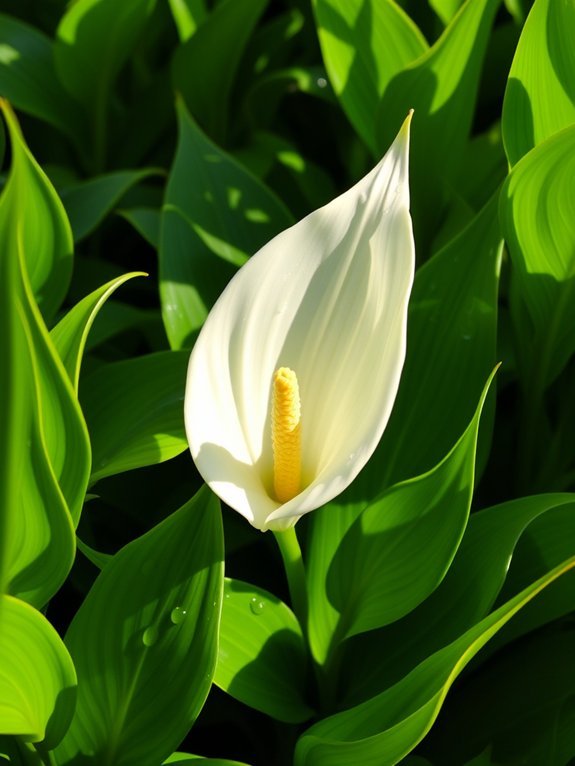
A Peace Lily (Spathiphyllum) is an excellent choice for indoor gardening enthusiasts seeking a touch of elegance and tranquility. These lovely plants boast glossy, dark green leaves that create a striking contrast with their white blooms, known as spathes. While typically grown indoors, they can adapt well to outdoor conditions when placed in shaded areas with indirect sunlight. You’ll find them thriving in well-draining soil, preferring moist environments but detesting overwatering. Regularly misting the leaves can enhance humidity levels, promoting healthy growth. The Peace Lily is also known for its air-purifying properties, making it a functional addition to your outdoor space. Whether for aesthetics or practicality, this plant delivers beauty and benefits galore.
Rubber Plant (Ficus Elastica)

If you’re captivated by the elegance of indoor plants like the Peace Lily, the Rubber Plant (Ficus Elastica) presents another formidable option. With its broad, glossy leaves that can grow several inches long, the Rubber Plant serves as a striking statement in any outdoor setting. It thrives in bright, indirect sunlight, favoring warm conditions, so placing it in a sheltered spot can yield impressive growth. You’ll appreciate its air-purifying qualities, making it beneficial for both aesthetics and health. Just remember to water it moderately—allow the topsoil to dry out between waterings. Its versatility means it can adapt to various soil types, adding to its charm as a resilient plant that can showcase sophistication while remaining easy to care for.
Dracaena

Dracaena stands out as a versatile and visually appealing choice for indoor gardening enthusiasts. With its long, arching leaves and stunning variegation, it not only enhances any space but also adapts well outdoors. You’ll find various species, like Dracaena marginata and Dracaena fragrans, each adding unique character to your garden. These plants thrive in indirect sunlight, making them perfect for shaded outdoor areas. While they prefer well-draining soil, they’re surprisingly tolerant of drought. Just be cautious of overwatering, as this can lead to root rot. Fertilizing every few months during the growing season promotes robust growth. By selecting Dracaena, you’ll enjoy a stylish plant that’s easy to care for, whether indoors or out.
Recommended Items
Discover our top picks to help your indoor plants flourish outdoors—let’s dive in!
Aloe Vera
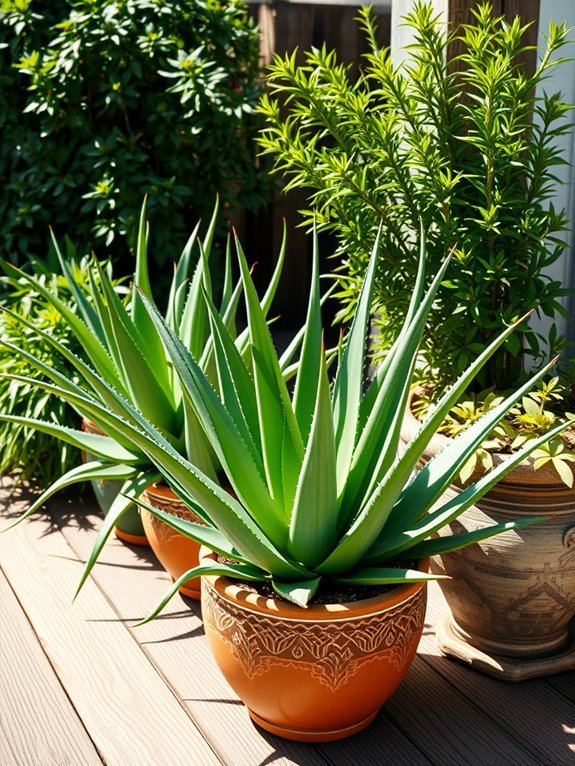
Renowned for its striking, fleshy leaves and valuable medicinal properties, Aloe Vera is a popular choice among indoor plant enthusiasts. This succulent thrives in bright, indirect sunlight, making it an ideal candidate for both indoor and outdoor spaces. Its ability to tolerate drought means you won’t need to water it often; just let the soil dry out completely between watering sessions. When exposed to outdoor conditions, Aloe Vera can grow even larger, producing offsets, or “pups,” that you can propagate. The gel inside its leaves provides soothing relief for minor burns and skin irritations, highlighting its usefulness. With minimal care and an impressive appearance, Aloe Vera can transform your garden or patio into a lush oasis.
Boston Fern (Nephrolepis Exaltata)

The Boston Fern (Nephrolepis exaltata) is a lush and elegant indoor plant that adds a touch of greenery to any space. Known for its feathery, arching fronds, this plant thrives in humid environments, making it a fantastic choice for both indoors and outdoors. To successfully grow it outdoors, you’ll want to place it in a shaded area with indirect sunlight, as direct light can scorch its delicate leaves. Water it consistently to maintain soil moisture and avoid letting it dry out. Keep in mind that Boston ferns appreciate high humidity, so consider misting them or placing a humidifier nearby. By meeting these conditions, you can enjoy their vibrant foliage while enhancing your outdoor garden’s aesthetic.
Parlor Palm (Chamaedorea Elegans)
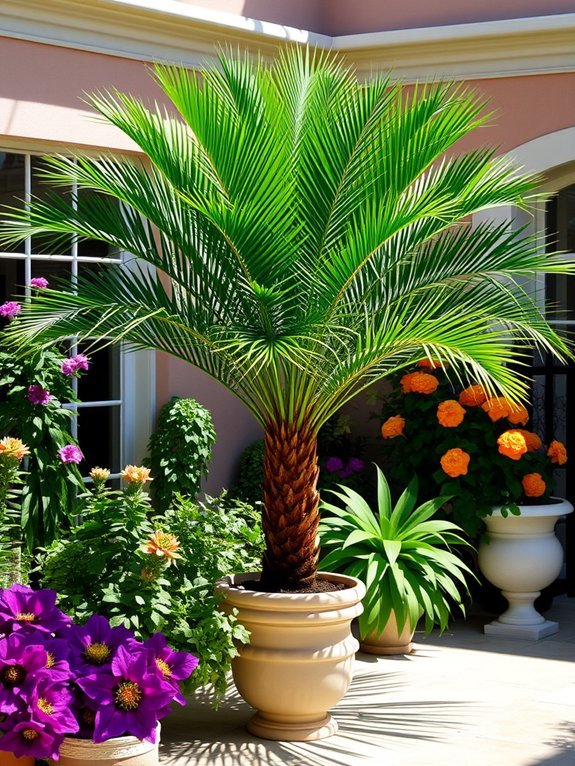
Although many indoor plants struggle with low-light conditions, the Parlor Palm (Chamaedorea elegans) flourishes in them, making it a popular choice for homes and offices alike. Its graceful, arching fronds can grow up to four feet tall, adding an elegant touch to any space. You’ll appreciate its ability to thrive in indirect light and tolerate a range of humidity levels. When planted outdoors, it can adapt well to partial shade, enhancing your patio or garden. Water it sparingly, allowing the soil to dry out between waterings, which helps prevent root rot. Its slow growth means it won’t outgrow your space quickly, making it an ideal long-term investment for greenery that enhances your environment beautifully.
Fiddle Leaf Fig (Ficus Lyrata)
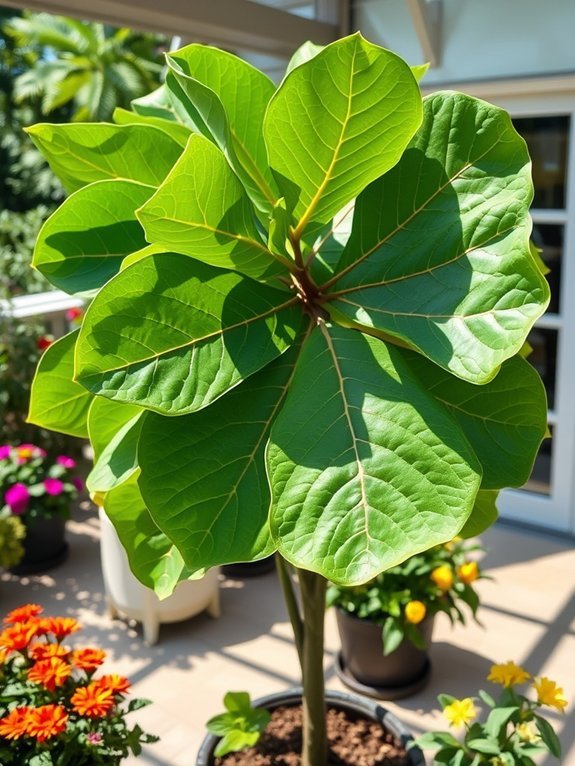
If you’re aiming for a bold statement in your indoor decor, the Fiddle Leaf Fig (Ficus lyrata) is a fantastic choice. Its large, glossy leaves create a striking visual impact, making it a favorite among interior designers. Thriving in bright, indirect light, this plant can also adapt to outdoor settings if given the right conditions. Make certain you provide well-draining soil and moderate humidity for peak growth. Here’s a quick overview of its key features:
| Feature | Details |
|---|---|
| Light Requirements | Bright, indirect light |
| Ideal Soil Type | Well-draining potting mix |
| Watering Frequency | When the top inch dries |
| Outdoor Tolerance | Mild climates only |
With proper care, the Fiddle Leaf Fig flourishes, adding elegance and sophistication to your space.
Chinese Evergreen (Aglaonema)
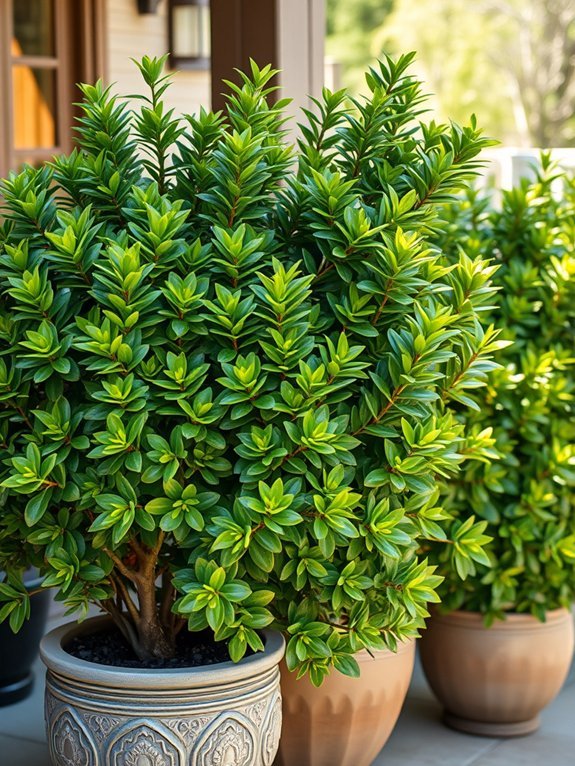
With its vibrant foliage and resilient nature, the Chinese Evergreen (Aglaonema) stands out as an ideal choice for both novice and experienced plant enthusiasts. This tropical plant thrives in a range of conditions, making it perfect for your outdoor decor. You’ll appreciate its glossy, variegated leaves that vary from deep greens to striking silver or pink patterns. Plant it in well-draining soil and provide partial shade to guarantee it flourishes. Aglaonema is highly forgiving, tolerating irregular watering and low-light conditions, allowing flexibility in care routines. Additionally, it’s known for its air-purifying properties, enhancing your outdoor space’s aesthetic and atmosphere. With minimal effort, you’ll enjoy the beauty and benefits this hardy plant brings to your garden.
Step-by-Step Guide to Outdoor Plant Decor
Heartleaf Philodendron (Philodendron Hederaceum)
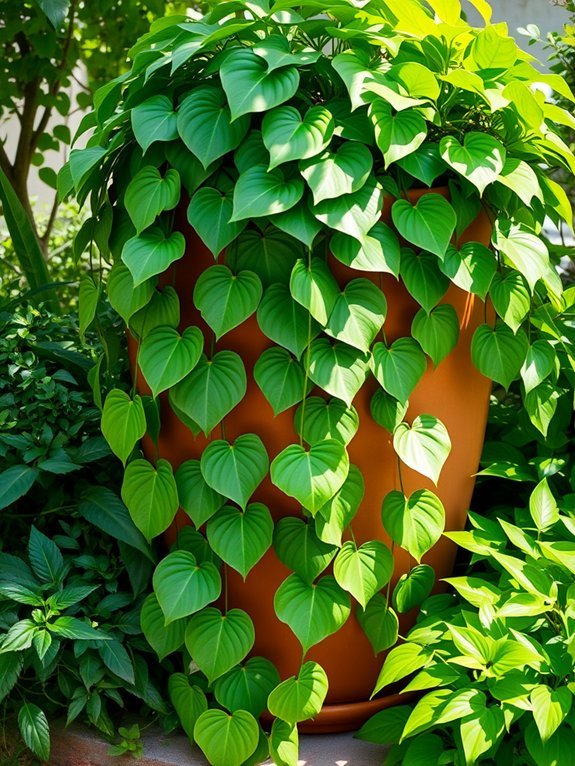
The Heartleaf Philodendron (Philodendron Hederaceum) captivates indoor plant enthusiasts with its trailing vines and heart-shaped leaves, making it a popular choice for enhancing both style and ambiance in any space. Its adaptability guarantees it thrives in various environments, whether hanging in a pot or climbing a trellis. This plant prefers bright, indirect light but can tolerate low light, which adds to its versatility outdoors. Keep the soil consistently moist, but avoid waterlogging to prevent root rot. As it spreads, you’ll appreciate how the glossy leaves can create a lush effect that attracts attention. With minimal care, the Heartleaf Philodendron continues to flourish, offering a touch of nature wherever you place it—even outdoors in a sheltered spot.
Begonia

Begonias, known for their stunning foliage and diverse flower colors, make a striking highlight in any indoor garden. Their adaptability allows you to shift them outdoors, enriching your exterior spaces. When growing begonias, consider factors like light, watering, and soil type. Here’s a quick reference guide to help you choose the right variety:
| Begonia Type | Ideal Conditions |
|---|---|
| Rex Begonia | Partial shade, well-drained soil |
| Wax Begonia | Bright, indirect light, regular watering |
| Dragon Wing Begonia | Full sun, moderate moisture |
| Angel Wing Begonia | Bright light, keep soil moist |
| Rhizomatous Begonia | Low light, allow to dry slightly |
With the right care, these beauties will thrive both indoors and out!
Lavender (Lavandula)
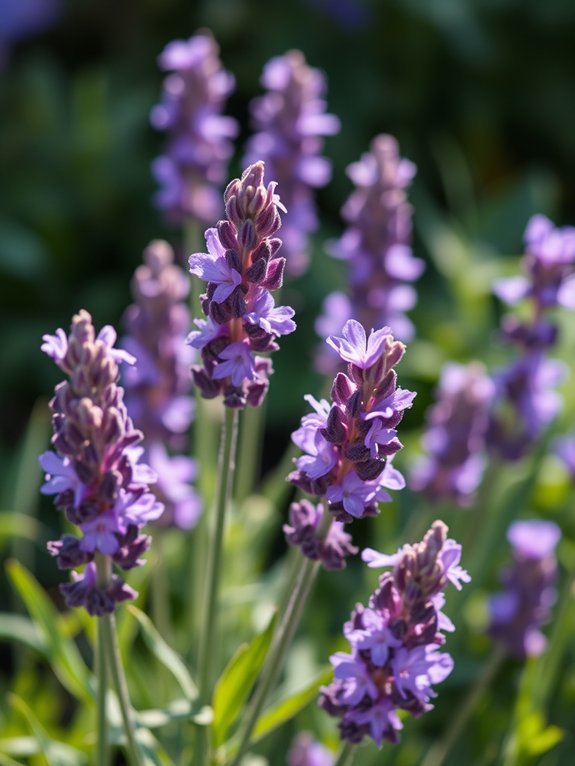
While you might typically associate lavender with gardens, its aromatic presence can also elevate your indoor spaces. This versatile plant thrives indoors when you provide the right conditions, making it a beautiful addition to your decor. To successfully grow lavender indoors, consider these key factors:
- Light: Place it near a sunny window where it can receive at least six hours of direct sunlight.
- Soil: Use well-draining soil to prevent root rot—lavender prefers sandy or loamy mixtures.
- Watering: Water sparingly; let the soil dry out between watering sessions. Overwatering can be detrimental.
- Temperature: Keep it in a warm environment, ideally between 60°F to 70°F, as lavender thrives in warm conditions.
Embrace these guidelines for a fragrant and vibrant indoor experience.
Coleus
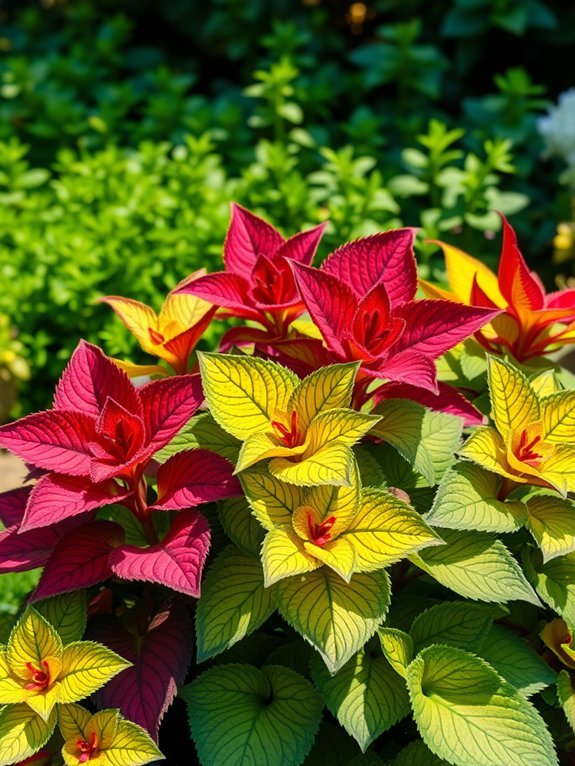
Coleus brings vibrant color and dynamic foliage to indoor spaces, making it a popular choice among plant enthusiasts. With leaves ranging from bright greens to deep purples and reds, you’ll find a coleus variety that suits your aesthetic. These plants thrive in indirect sunlight, so placing them near a window can enhance their colors without risking leaf scorch. You’ll need to keep the soil consistently moist but well-drained to prevent root rot. As summer approaches, consider moving your coleus outdoors; it flourishes in warm temperatures and enjoys partial shade. Regular pruning helps maintain its bushy shape and encourages new growth. Overall, coleus is a versatile choice that can elevate your garden while brightening your indoor environment.
Croton (Codiaeum Variegatum)
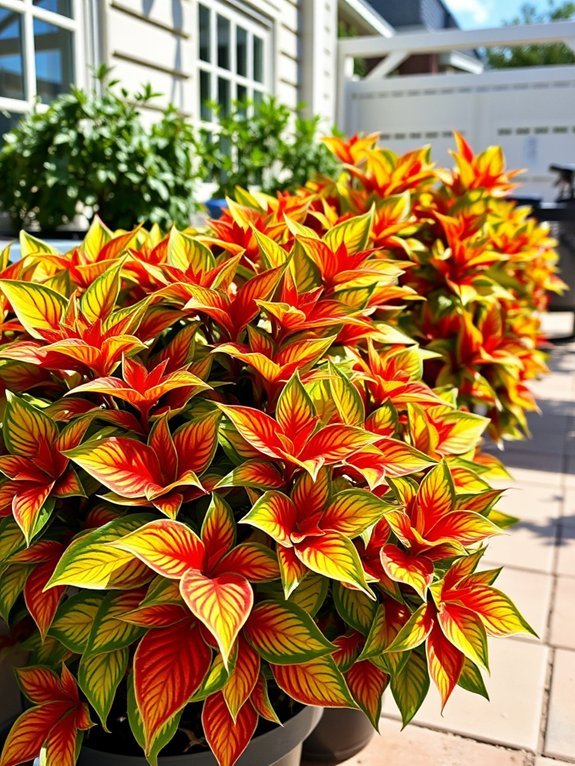
After exploring the vibrant hues of coleus, consider Croton (Codiaeum variegatum) for your indoor plant collection. This stunning plant showcases a variety of colors, making it a striking focal point in any room. When you care for your Croton, keep these essentials in mind:
- Light: It thrives in bright, indirect sunlight.
- Water: Water regularly, but let the top inch of soil dry out before re-watering.
- Humidity: High humidity will keep its leaves lush and vibrant; consider misting.
- Temperature: Maintain a warm environment; keep it above 60°F (15°C).
With the right conditions, Croton can bring a burst of color and life to your space, adapting beautifully to outdoor settings as well.
Hoya
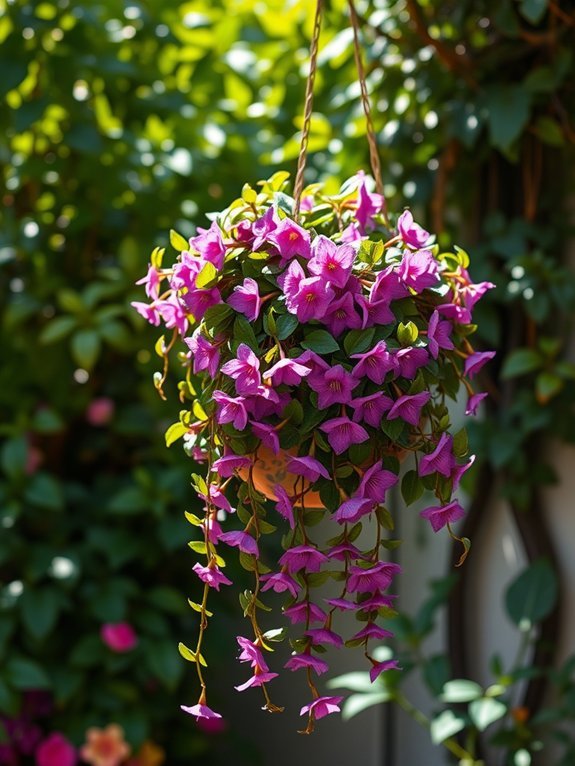
Hoya, often referred to as the “wax plant” due to its thick, shiny leaves, is a delightful addition to your indoor garden. With its stunning appearance and unique floral clusters, this plant thrives in bright, indirect sunlight, making it perfect for patios or balconies. You’re likely to appreciate its low maintenance needs—Hoya only requires watering when the soil is dry. When kept outdoors, guarantee warmth, as it loves temperatures above 60°F. Its fragrant flowers, resembling small stars, not only enhance your space’s beauty but also attract pollinators like butterflies. Hoya’s ability to adapt can make it a standout element, enriching both your indoor and outdoor garden environments. Embrace its charm, and watch it flourish.
Bromeliad
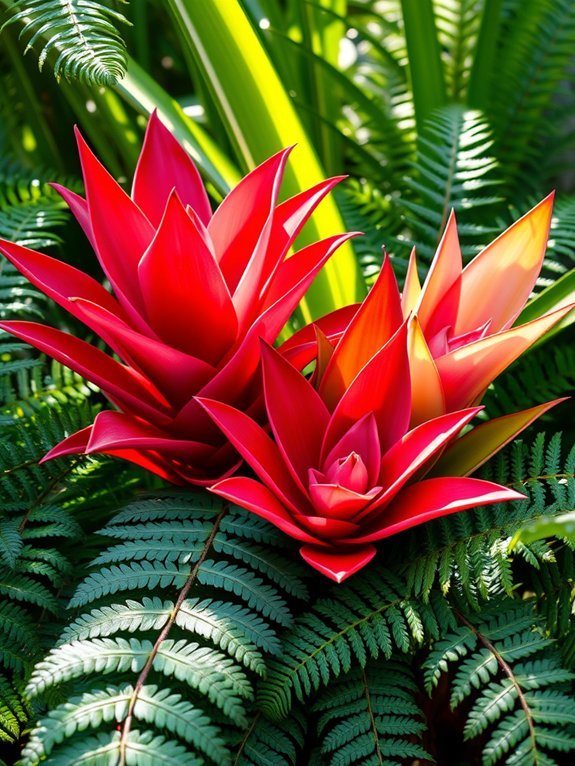
Bromeliads are vibrant, exotic plants that can effortlessly bring a splash of color to your indoor space. These hardy plants thrive in both indoor and outdoor settings, making them versatile options for your collection.
To help you appreciate their unique features, consider these points:
- Color Variety: They come in shades of red, orange, yellow, and pink, creating eye-catching focal points.
- Unique Formation: Their rosette shape and striking inflorescence distinguish them from other houseplants.
- Low Maintenance: Bromeliads require minimal care, needing water only in their central cups, which reduces the risk of overwatering.
- Air Quality: They filter pollutants, contributing to a healthier indoor environment.
With the right care, bromeliads can truly elevate your living space.
